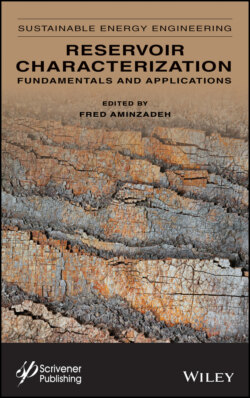Читать книгу Reservoir Characterization - Группа авторов - Страница 49
3.6 Optimization of Aggregated AD Classifier Using Part of the Anomaly Identified by Universal Classifiers
ОглавлениеIt was shown in the previous section that a divergence AD classifier is very efficient in detecting an anomaly with known properties. It was noted also that universal classifiers have lower efficiency compared to divergence.
The goal of this section is to develop a methodology for construction of an adaptive AD classifier working as a universal classifier for detection of anomalies of unknown type that is still almost as efficient as the specialized divergence classifier. The methodology for its synthesis is a two-step procedure:
1 1. Detection of a part of the anomaly using universal classifiers, such as the distance or the sparsity.
2 2. Optimization of aggregated classifier on the detected part of anomaly.
The structure of the aggregated classifier is defined by a set of coefficients sm (Eq. 3.7). These coefficients are chosen so that they maximize the ratio:
where sm; 1 ≤ m ≤ M are weights and aggr() is defined by Eq. 3.7, classifier Anomaly Records are records identified by a universal classifier as anomaly, trainSetRecords are records from the training set.
To find coefficients sm that maximize efficiency criterion (3.8) we used a multidimensional grid search. In the grid search, the coefficients sm in Eq. 3.7 take on a discrete set of values in the following region:
(3.9)
The efficiency criterion (3.8) is calculated for each combination of coefficients sm at individual grid nodes. An adaptive aggregated AD classifier maximizes efficiency criterion on the grid. As soon as the aggregated classifier is synthesized it may be used for anomaly detection using the test set.
We illustrate construction of an adaptive aggregated classifier using the sparsity classifier at the first optimization step. The classifier to be synthesized is of the following form:
(3.10)
Therefore, search is done on the two-dimensional grid.
Figure 3.7 shows values of the sparsity classifier used as the first step of optimization of the aggregated classifier. Twenty regular records that form the training set are randomly selected out of a set of 50 records. The test set contains 30 regular and 25 anomaly records. Anomaly records are from gas-filled sands. Regular ones are from brine-filled sand or shale. The assigned value of the expected false discovery rate was 20%. Records classified as a potential anomaly include 13 actual anomaly records and 2 regular records. Thus the posterior true discovery rate is very moderate - 52%.
Figure 3.7 Sparsity values on the records of the training and test sets. Horizontal dashed line - anomaly detection cutoff producing an expected false discovery rate of 20%.
Figure 3.8 Anomaly detection. Histograms of posterior true discovery rate (TDR) for two values of expected false discovery rate. AD method: aggregated. 20 regular records in each training set.
Table 3.2 Mean and three quantiles of distribution of AUC values.
| Mean | Quantiles | Width of quantile region | |||
|---|---|---|---|---|---|
| P=0.05 | Median P=0.5 | P=0.95 | |||
| Divergence | 0.897 | 0.89 | 0.895 | 0.909 | 0.019 |
| Aggregated | 0.866 | 0.862 | 0.87 | 0.901 | 0.039 |
| Distance | 0.795 | 0.633 | 0.818 | 0.885 | 0.252 |
| Sparsity | 0.765 | 0.576 | 0.786 | 0.868 | 0.292 |
The results shown in Figure 3.8 characterize the performance of an adaptive aggregated classifier that was applied to 1000 bootstrap randomly formed training - test datasets. Optimization of the aggregated classifier was done on the part of the test records identified by the sparsity as anomaly. Figure 3.8 shows histograms of values of the posterior true discovery rate for expected false discovery rates of 20% and 5%. According to Figure 3.8, a higher expected false discovery rate of 20% leads to a higher posterior true discovery rate in the range of 83%- 87%. In the case of lower expected FDR of 5%, posterior discovery rate is within 70% -85%.
The results of comparative analysis of the performance of several classifiers in detection of gas-filled sand anomaly are shown in the Table 3.2. This table shows mean, median, and two quantiles of posterior AUC values for four classifiers. According to the Table 3.2, the highest quality results are produced with the divergence classifier. Performance of the adaptive aggregated classifier is slightly lower but close to performance of divergence. The distance and the sparsity classifiers are characterized by smaller median AUC values and wider widths of the quantile region.
